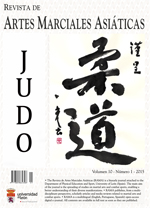El Dojang: escuela de disciplina y moralidad
DOI:
https://doi.org/10.18002/rama.v10i1.1445Palabras clave:
Corea del Sur, artes marciales, deportes de combate, taekwondo, gumdo, trabajo corporal, disciplina, educaciónResumen
Las artes marciales pueden ser definidas como historia en movimiento. Pocas actividades deportivas de popularidad internacional movilizan corporalmente un repertorio simbólico y práctico de moralidad ética y sensualidad estética tan complejo y distintivo de un pueblo como las disciplinas marciales coreanas, en especial el taekwondo y el gumdo. Al igual que en otros deportes de combate, el gimnasio de artes marciales (dojang) es el lugar donde se producen y reproducen los valores y se apropian las habilidades, conocimientos y reconocimientos – títulos, certificados, etc. – que legitiman la entrega, corporal y social, de un individuo a un disciplina marcial. El presente artículo busca transmitir al lector las emociones que genera en un neófito la práctica de un arte marcial y las tensiones sociales y kinestésicas que se experimentan como resultado de esta acción en la moderna sociedad coreana. Asimismo, explora algunos factores históricos vinculados a su desarrollo y acelerada expansión en apenas medio siglo.
Descargas
Métricas alternativas
Citas
Bourdieu, P., & Wacquant, L. (2005). Una invitación a la sociología reflexiva. Buenos Aires: Siglo XXI Editores.
Bourdieu, P. (2007). Programa para una sociología del deporte. En Cosas Dichas (pp. 173-184). Barcelona: Gedisa.
Choi H. H. (1996). Taekwon-Do. El arte coreano de la defensa personal. Buenos Aires: International Taekwon-Do Federation.
Crossley, N. (2005). Mapping Reflexive Body Techniques: On Body Modification and Maintenance’. Body & Society, 11(1), 1-35.
Donohue, J. J. (1994). Warrior Dreams: The Martial Arts and the American Imagination. Westport, CT: Bergin & Garvey.
Donohue, J. J. (1998). Herding the Ox. The Martial Arts as Moral Metaphor. Wethersfield, CT: Turtle Press.
Durkheim, E. (2004). La división del trabajo social. Buenos Aires: Libertador.
Elias, N., & Dunning, E. (1992) Deporte y ocio en el proceso de la civilización. México: Fondo de Cultura Económico.
Foucault, M. (1996). La verdad y las formas jurídicas. Barcelona: Gedisa.
Goffman, E. (2001). La presentación de la persona en la vida cotidiana. Buenos Aires: Amorrortu.
Graham, E. (2013). ‘There Is No Try in Tae Kwon Do’: Reflexive Body Techniques in Action. En R. Sánchez & D. Spencer (Eds.) Fighting Scholars. Habitus and Ethnographies of Martial Arts and Combat Sports (pp. 63-77). London & New York: Anthem Press.
Hobsbawm, E. (2002) Introducción: la invención de la tradición. En E. Hobsbawm & T. Ranger (Eds.), La invención de la tradición (pp. 7-21). Barcelona: Crítica.
Iedwab, C. A., & Standefer, R. L. (2001). El arte secreto de la salud y la buena forma física. Madrid: Miraguano.
Kim, K. D. (Ed.). (2008). Social Change in Korea. Paju: Jimoondang.
Kim, M.-H. (1999). L'origine et le developpement des arts martiaux. Pour une anthropologie des techniques du corps. Paris: L’Harmattan.
Korea Focus. (2013, 13 de marzo). The Korean Wave Creeps into Cultural Heritage. Korea Focus. Recuperado de http://www.koreafocus.or.kr/design3/Culture/view.asp?volume_id=137&content id=104670&category=C
Lee J. K. (2006). Educational Fever and South Korean Higher Education. Revista Electrónica de Investigación Educativa, 8(1), 1-14.
Martínez Guirao, J. E. (2011). Una etnografía de las artes marciales. Procesos de cambio y adaptación cultural en el taekwondo. Alicante: Editorial Club Universitario.
Mauss, M. (1979). Técnicas y Movimientos Corporales. En Sociología y Antropología (pp. 335-356). Madrid: Tecnos.
Sánchez, R., & Spencer, D. (Eds.) (2013). Fighting Scholars. Habitus and Ethnographies of Martial Arts and Combat Sports. London & New York: Anthem Press.
Sánchez, R. (2013). Taming the Habitus. The Gym and the Dojo as ‘Civilizing Workshops’. En R. Sánchez & D. Spencer (Eds.) Fighting Scholars. Habitus and Ethnographies of Martial Arts and Combat Sports (pp. 155-170). London & New York: Anthem Press.
Seth, M. J. (2008). Fiebre educativa: sociedad, política, y el anhelo de conocimiento en Corea del Sur. Buenos Aires: Prometeo.
Vogel, A., Mello, M. A. da S., & Barrios, J. F. P. de (2014). La gallina de Angola. Buenos Aires: Antropofagia.
Wacquant, L. (1999). Un arma sagrada. Los boxeadores profesionales: capital corporal y trabajo corporal. En J. Auyero (Comp.), Caja de herramientas. El lugar de la cultura en la sociología norteamericana (pp. 237-292). Buenos Aires: Universidad de Quilmes.
Wacquant, L. (2006). Entre las cuerdas. Cuadernos de un aprendiz de boxeador. Buenos Aires: Siglo XXI Editores.
Wagner, E. W., Carter, J. E., Lee K. B., Lew Y. I., & Robinson, M. (1990). Korea Old and New: A History. Seúl: Ilchokak.
Descargas
Publicado
Cómo citar
Número
Sección
Licencia
Derechos de autor 2015 Gonzalo Ariel Millán

Esta obra está bajo una licencia internacional Creative Commons Atribución-NoComercial-CompartirIgual 4.0.
Los autores que publican en esta revista están de acuerdo con los siguientes términos:
- Los autores ceden de forma no exclusiva los derechos de explotación (reproducción, distribución, comunicación pública, transformación) a la Universidad de León, por lo que pueden establecer, por separado, acuerdos adicionales para la distribución no exclusiva de la versión de la obra publicada en la revista (por ejemplo, alojarlo en un repositorio institucional o publicarlo en un libro), con un reconocimiento de su publicación inicial en esta revista.
- Este trabajo se encuentra bajo la Creative Commons Attribution-NonCommercial-ShareAlike 4.0 International License. Puede consultarse desde aquí la versión informativa y el texto legal de la licencia.
- Se permite y se anima a los autores a difundir electrónicamente las versiones pre-print (versión antes de ser evaluada) y/o post-print (versión evaluada y aceptada para su publicación) de sus obras antes de su publicación, ya que favorece su circulación y difusión más temprana y con ello un posible aumento en su citación y alcance entre la comunidad académica.











